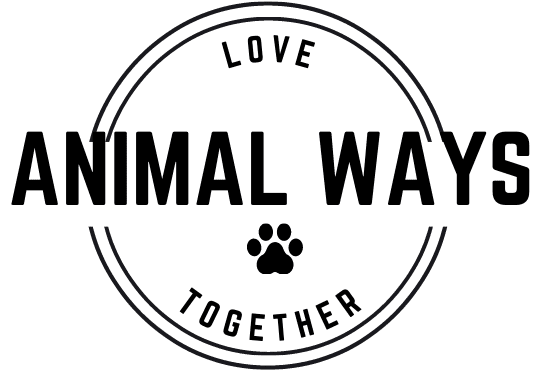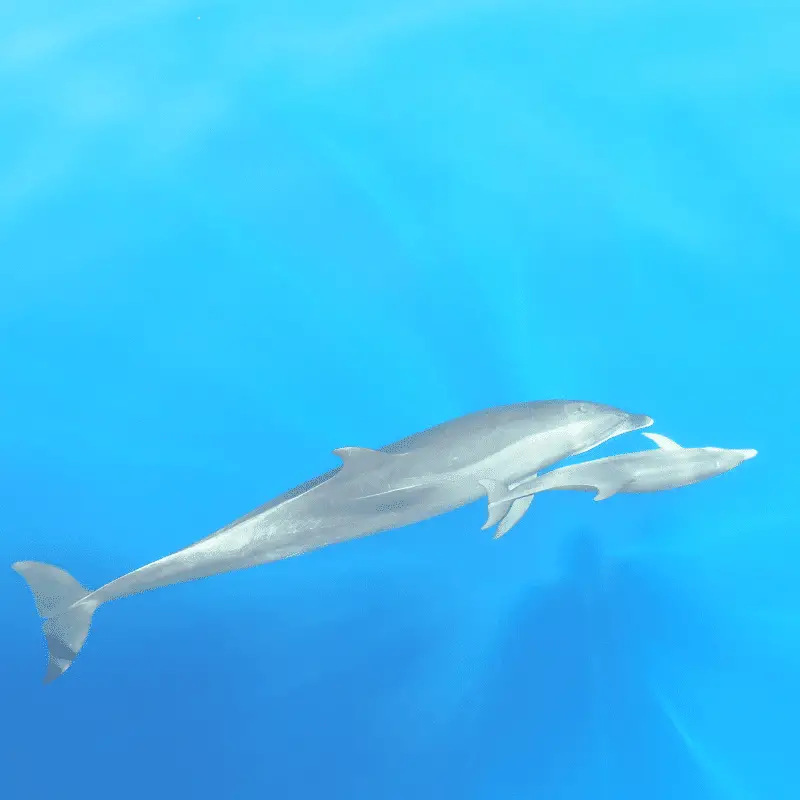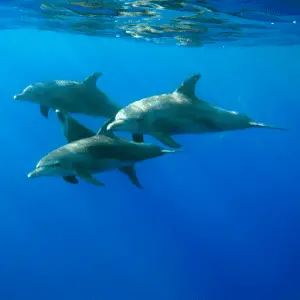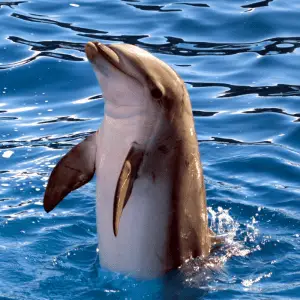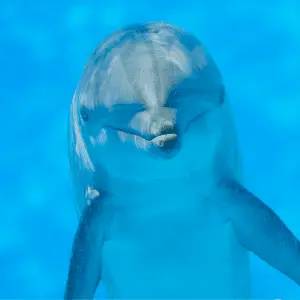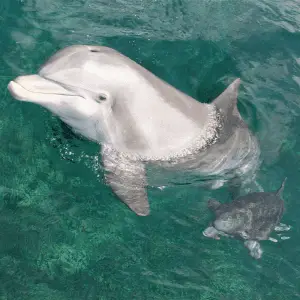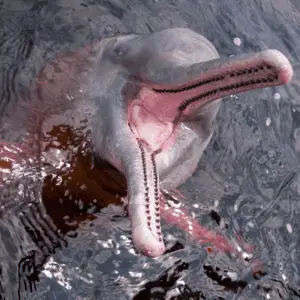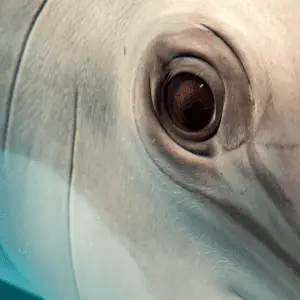Dolphin babies drink milk from their mother’s mammary glands on the underbelly of a female dolphin on either side of the genital slit just before the fluke. Mother dolphins nurse their babies for the first two to three years of their lives. However, in some rare cases, mother dolphins have been known to nurse their babies for up to ten years. As dolphin milk is very rich and contains a lot of fat content, it helps the babies grow healthy.
Do baby dolphins drink just milk?
Baby dolphins learn to hunt for fish to eat and drink alongside their mother’s milk till around three years old. Dolphins will drink only their mothers’ milk until approximately two years old. After this time, the mother dolphin slowly guides them to catch little fish.
Sometimes nursing can go on till approximately ten years of age; however, it’s sporadic for mother dolphins to do this.
How do baby dolphins drink milk?
The feeding technique of dolphin babies is different from all terrestrial mammals. The dolphins do not have any breasts. Instead, the female dolphins have nipples hidden inside their mammary slit on their underbelly.
The babies poke in this area at the time of feeding, which makes the mother aware that the babies are ready to feed.
Once that happens, the nipples come out of that slit. The babies put their mouths around the slit and create a cone-like structure using their tongues.
The mother dolphin then squirts milk right inside the baby’s mouth. The cone-like structure created by the baby dolphins using their tongue makes an airtight grip. The airtight grip enables them to drink underwater and helps them ensure that not a single drop of precious milk gets wasted.
When can baby dolphins start hunting on their own?
Some baby dolphins can start hunting on their own when they are about 4 to 5 months of age. They are still heavily dependent on their mothers’ milk during this time. However, under the careful supervision of their mother, the babies slowly start to hunt for smaller fish; however, they won’t eat the fish until they are a little older.
Did you know that dolphins swallow their food whole? And due to this, they required an extra chamber within their stomach for breaking down the food. Find here fascinating information on the dolphin’s stomachs and digestive system.
How do baby dolphins hunt for fish?
Baby dolphins often use a unique technique for hunting fish, known as snacking. In this technique, the baby dolphin swiftly swims in a barrier position just under the water’s surface, trapping tiny fishes that float between the water’s surface and the air.
Even though the size of these fish is tiny, it helps the babies acquire some experience when they need to hunt for bigger fish in their later life.
How long do the dolphin calves stay with their mothers?
Dolphin babies form a strong relationship with their mothers immediately after birth. Most of the time, the babies stay with their mothers until they are weaned completely. That means baby dolphins remain with their mothers until they are three years old.
However, it’s known that many baby dolphins stay with their mothers until they are well into their teenage years.
When are baby dolphins classed as mature?
Dolphin babies mature when they are 5 to 10 years of age. They take significant energy and time to ensure their babies are ready to take on the sea world. The dolphin mothers are excellent teachers. They teach youngsters all the necessary life skills to lead an independent life.
Training
The mother dolphins teach their babies the techniques to catch prey, avoid predators and find their way to their pod. Not only that, but the mother dolphin also helps their babies learn their language and how they should interact with the other group members.
Baby Dolphin Diet Other Than Milk
Mature dolphins are active predators that feed on various marine life. Under the close supervision of their mothers, the baby dolphins often feed on squid, small fish, and crustacean animals, like shrimps.
The baby dolphin’s primary food changes according to its geographic location. For example, coastal dolphin babies feed on fish and bottom-dwelling invertebrates.
Baby dolphins also hunt with the help and cooperation of other group members. The other members take turns trapping the fish into smaller corners while the babies hunt for their meals within the trapped spool of fish.
Amount
Every day, baby dolphins consume about 8 to 15 kgs of food.
What does dolphin milk look like?
Dolphin milk has a very thick consistency due to its high fat content. The fat content of dolphin milk can reach up to 180 gms per litre. The dolphin milk is white with a yellowish tinge. The milk has a creamy consistency which prevents it from getting wasted due to leakage when the baby feeds on it.
What does dolphin milk smell like?
Dolphin milk has a fishy smell.
What does dolphin milk taste like?
The taste of dolphin milk is unsweetened and exceptionally oily, and it comes with a strong fishy smell.
Can dolphin babies survive on their own?
No, baby dolphins need their mothers to survive. Baby dolphins rely on their mothers for food, guidance and protection. They are heavily dependent on their mothers until at least two years old.
Why Baby Dolphins Need Their Mum
Dolphin babies cannot use their language right after birth. Learning echolocation techniques takes a lot of time and practice.
Dolphin babies often take significant time to develop their whistle, which they can use as their identification brand.
It also takes careful teaching from their mother to understand the threats to marine life and how they can avoid them.
The dolphin mother helps the babies learn hunting skills and social behaviour.
The nutrition and the fat content that comes from the milk of the dolphin mother are vital for the babies to survive.
No baby dolphin can thrive if they do not have its mother’s milk to start with.
The newborn dolphin babies do not come with the necessary fat. It’s the vital fat coating that helps dolphins stay afloat on their own.
The dolphin mothers also keep their calves afloat after they are born. So, if the babies do not have the help of their mothers, they will not be able to swim or even stay afloat.
The dolphin calves are so dependent on their mothers in this regard that if the mother falls asleep and stops swimming for some time, the calves will drown.
